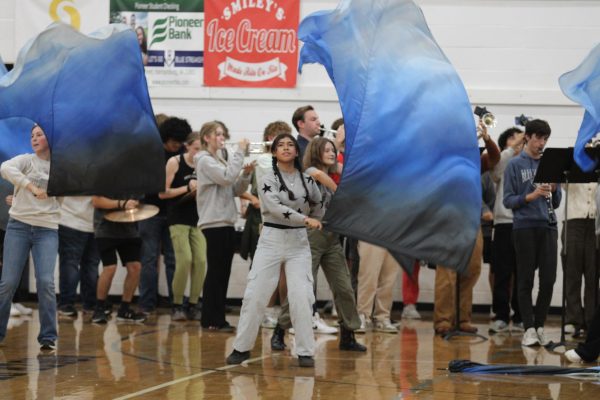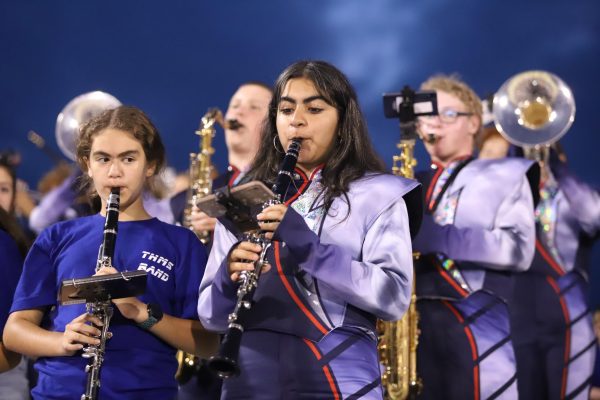Robotics team advances to states, adjusts to competing during pandemic
(Photo taken January 2020) Senior Thomas Shulgan and sophomore Niranjan Aradhey, members of team Error Code 404, regroup after losing a robotics match at a competition last year.
The Harrisonburg High School Robotics Team, led by Geoffray Estes, has been going on since 2012 and is still running successfully. Saturday, Feb. 27, team Error Code 404 attended their second FTC competition. There, they received the Innovate Award and will be moving onto states.
This year, competitions are not much different compared to previous years considering that there’s a pandemic happening. The only difference that they face is not being able to have 30 robotics teams in one room during a competition. Instead, according to Estes, they have two teams competing against each other rather than competing against multiple teams.
“Because of the fact that we’re still under that pandemic watch, the directors of First Chesapeake, which is our regional robotics competition board, really had to be creative in the way they pushed for our students to be able to compete this year because in the beginning, we weren’t sure if we were going to be able to. The big difference between this year and years past [is] we would go to two regional competitions and those competitions would have about 30 teams or so at each competition. [This year,] we were competing head-to-head on the field so it was one alliance versus another alliance… You would earn points based on how well you did during your alliance matches,” Estes said.
Due to the COVID-19 pandemic, the main change that First Chesapeake had to make when configuring this year’s robotics competitions was that in the regional competition, teams are competing with one other team that is on their same alliance. The team tries to score as many points as they can rather than competing against another group.
“In this day and age with the pandemic, the change that they had to make was that you’re no longer in the regional competition really competing against another team because of restriction of only allowing ten people in a venue at a time where we used to be able to fit hundreds we are actually in our regionals competing with one other team but we’re on the same alliance and we’re just trying to score as many points as we can versus competing against each other trying to score as much as we can and surpass the other team,” Estes said.
When comparing on the field this year, it is more about trying to get as many points as you can rather than competing head-to-head with another team. The teams can still do what they normally would do at the competitions but now they just need to follow COVID guidelines.
“It’s more of a spirit of cooperation when you’re on the field this year and trying to help lift each other to get the greatest number of points that you can, and then as we head into the state competition, the rules change a little bit from the regionals where… we play five rounds and the first two rounds we actually play against a team, like a head-to-head against a team. For the last three rounds, those two teams [that were] playing head-to-head against each other are now on an alliance together and trying to do what we did in the regionals where we’ll work together to score as many points as possible. So besides the format, the other big thing that has changed is just, like I mentioned before the amount of people that could come and watch face to face, the COVID restrictions that have been put in to place, the testing as you walk into the building… it just looks different. We’re still able to do most of the things we’re used to doing in terms of the competition but we just have to follow a slightly different path,” Estes said.
Sophomore Anish Aradhey is on the team, and one of his proudest moments during a robotics competition was when he got to see his team’s robots run in the first 30 seconds of the competition without any driver. As he is part of the programming group on the robotics team, they work hard to make the robot run by itself without any guidance.
“In the beginning of each robotics match during the competition,… there’s like 30 seconds where your robot has to complete a program without any driver input, so completely on its own, and it’s called autonomous. That’s something that as part of the programming team on the robotics team, [we] work a lot on is trying to make the robot function on its own. During the last competition, we got some really successful consistent runs with that autonomous program, and that was something that was really exciting for us,” Aradhey said.
Something that Estes hopes for his robotics students to learn from their competitions is that they need to know that problem solving does not just belong to one category. He wants them to know that they are not just solving technical problems but they are also using their knowledge from other classes to form a successful robot.
“I’m always one that says having the robot on the field at the end of the build season is sort of icing on the cake. All of the great learning happens from the first day back in September when we learned what this year’s design challenge was all the way up to the point where we dropped the robot off on the field, and what I hope that they learned in between which is where the important stuff happens is that problem solving doesn’t necessarily just sit in one particular discipline,” Estes said.
When trying to solve problems while creating the robot, the team finds ways to incorporate all of their knowledge into one in order to create the robot more efficiently. Estes believes a big part of problem-solving in the robotics field is about the engineering design process.
“We’re not just building a robot and solving only technical problems [but] we’re actually taking what we’ve learned in our science classes, in our math classes, in our computer science classes,… and a lot of our students have taken the engineering classes at HHS as well. We’re trying to find where all the natural intersections of those disciplines meet, and we want to look at the field of robotics as a great integrator, meaning that it’s a tool for us to see that when we problem solve, we have to pull from various disciplines in order to put all the pieces together to come up with a solution. So I hope that they see the integrative nature of how problem-solving can happen in a very successful way if they do it well or where they might need to improve if they missed a step somewhere. So it’s about the engineering design process to me,” Estes said.
Your donation will support the student journalists of Harrisonburg High School. Your contribution will allow us to purchase equipment and cover our annual website hosting costs.












